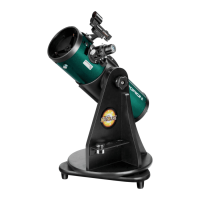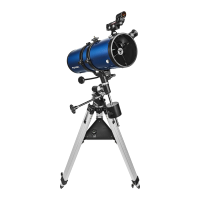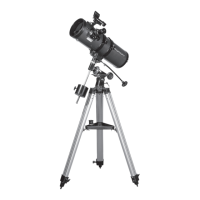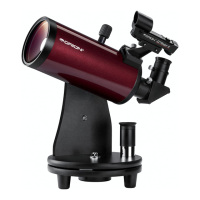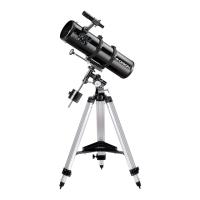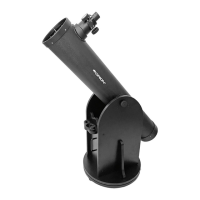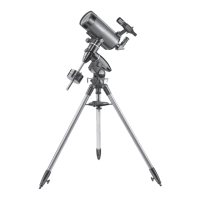9
Important Note: Do not look at the Sun with this telescope with-
out a professionally made solar lter installed on the front open-
ing, or permanent eye damage or blindness could result! Do not
use the red dot scope when solar viewing, either.
C. The Planets
Planets, being in our own solar system and having their own
orbits, do not stay at “xed" locations like the stars do. So to nd
them you should refer to Sky Calendar at our website (telescope.
com), or to charts published monthly in Astronomy or Sky &
Telescope magazines, or on astronomy websites. Venus, Jupiter,
and Saturn are the brightest objects in the sky after the Sun and
the Moon. Other planets may be visible but will likely appear star-
like. Because planets are quite small in apparent size, you will
need to use high power. Not all the planets are generally visible
at any one time.
JUPITER: The largest planet, Jupiter, is a great subject for
observation. You can see the disk of the giant planet and watch
the ever-changing positions of its four largest moons -- Io,
Callisto, Europa, and Ganymede.
SATURN: The ringed planet is a breathtaking sight when it is
well positioned. The tilt angle of the rings varies over a period of
many years; sometimes they are seen edge-on, while at other
times they are broadside and look like giant “ears" on each side
of Saturn’s disk. A steady atmosphere (good seeing) is neces-
sary for a good view. You will probably see a bright “star" close
by, which is Saturn’s brightest moon, Titan.
VENUS: At its brightest, Venus is the most luminous object
in the sky, excluding the Sun and the Moon. It is so bright that
sometimes it is visible to the naked eye during full daylight!
Ironically, Venus appears as a thin crescent, not a full disk, when
at its peak brightness. Because it is so close to the Sun, it never
wanders too far from the morning or evening horizon. No surface
markings can be seen on Venus, which is always shrouded in
dense clouds.
D. The Stars
Stars will appear like twinkling points of light. Even powerful tele-
scopes cannot magnify stars to appear as more than a point of
light. You can, however, enjoy the different colors of the stars and
locate many pretty double and multiple stars. The gorgeous two-
color double star Albireo in Cygnus is a favorite. Defocusing a
star slightly can help to bring out its color.
E. Deep-Sky Objects
Under dark skies, you can observe a wealth of fascinating deep-
sky objects, including gaseous nebulas, open and globular
star clusters, and a variety of different types of galaxies. Most
deep-sky objects are very faint, so it is important that you nd
an observing site well away from light pollution. Take plenty of
time to let your eyes adjust to the darkness. Do not expect these
subjects to appear like the photographs you see in books and on
the internet; most will look like dim gray smudges. Our eyes are
not sensitive enough to see color in deep-sky objects. But as you
become more experienced and your observing skills get sharp-
er, you will be able to ferret out more and more subtle details and
structure.
To nd deep sky objects in the sky, it is best to consult a star
chart, planetarium program or app, or a planisphere. These
guides will help you locate the brightest and best deep-sky
objects for viewing with your telescope. You can also try low-pow-
er scanning of the Milky Way. Pop in the 25mm eyepiece and just
cruise through the “star clouds" of our galaxy. You’ll be amazed
at the rich elds of stars and objects you’ll see! The Milky Way is
best observed on summer and winter evenings.
VI Care and Maintenance
If you give your telescope reasonable care, it will last a life-
time. Store it in a clean, dry, dust-free place, safe from rapid
changes in temperature and humidity. Do not store the tele-
scope outdoors, although storage in a garage or shed is okay.
Small components like eyepieces and other accessories
should be kept in a protective box or storage case. Keep the
dust cover on the front of the telescope when it is not in use.
VII. Specifications
Optical design Newtonian reector
Primary mirror gure Parabolic
Primary mirror coating Aluminum with SiO2
overcoat
Secondary mirror 53mm minor axis diameter
Secondary mirror coating Aluminum with SiO2
overcoat
Aperture 152mm
Focal length 750mm
Focal ratio f/5
Central obstruction diameter 49.8mm
Focuser Rack and pinion, 1.25"
Base MDF material with laminate
nish
Mounting saddle Vixen-style dovetail with
clamp knob
Optical tube mounting adapter Vixen-style dovetail bar
Eyepieces 25mm Plossl design, 1.25",
fully multi-coated
10mm Plossl design, 1.25",
fully coated
Magnication with supplied
eyepieces 30x (25mm) and 75x
(10mm)
Finder scope Red dot reex sight (3V
lithium ion battery included)
Weight, assembled telescope 22 lbs., 1 oz.
Optical tube length 27"
Base dimensions 18" x 18" x 18"
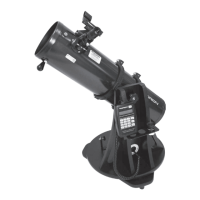
